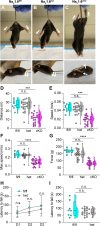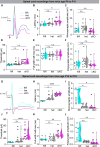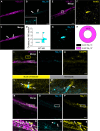Differential encoding of mammalian proprioception by voltage-gated sodium channels
- PMID: 39772670
- PMCID: PMC11708877
- DOI: 10.1126/sciadv.ads6660
Differential encoding of mammalian proprioception by voltage-gated sodium channels
Abstract
Animals requiring purposeful movement for survival are endowed with mechanoreceptors, called proprioceptors, that provide essential sensory feedback from muscles and joints to spinal cord circuits, which modulates motor output. Despite the essential nature of proprioceptive signaling in daily life, the mechanisms governing proprioceptor activity are poorly understood. Here, we identified nonredundant roles for two voltage-gated sodium channels (NaVs), NaV1.1 and NaV1.6, in mammalian proprioception. Deletion of NaV1.6 in somatosensory neurons (NaV1.6cKO mice) causes severe motor deficits accompanied by loss of proprioceptive transmission, which contrasts with our previous findings using similar mouse models to target NaV1.1 (NaV1.1cKO). In NaV1.6cKO animals, we observed impairments in proprioceptor end-organ structure and a marked reduction in skeletal muscle myofiber size that were absent in NaV1.1cKO mice. We attribute the differential contributions of NaV1.1 and NaV1.6 to distinct cellular localization patterns. Collectively, we provide evidence that NaVs uniquely shape neural signaling within a somatosensory modality.
Figures










Update of
-
Differential encoding of mammalian proprioception by voltage-gated sodium channels.bioRxiv [Preprint]. 2024 Aug 28:2024.08.27.609982. doi: 10.1101/2024.08.27.609982. bioRxiv. 2024. Update in: Sci Adv. 2025 Jan 10;11(2):eads6660. doi: 10.1126/sciadv.ads6660. PMID: 39253497 Free PMC article. Updated. Preprint.
Similar articles
-
Differential encoding of mammalian proprioception by voltage-gated sodium channels.bioRxiv [Preprint]. 2024 Aug 28:2024.08.27.609982. doi: 10.1101/2024.08.27.609982. bioRxiv. 2024. Update in: Sci Adv. 2025 Jan 10;11(2):eads6660. doi: 10.1126/sciadv.ads6660. PMID: 39253497 Free PMC article. Updated. Preprint.
-
NaV1.1 is essential for proprioceptive signaling and motor behaviors.Elife. 2022 Oct 24;11:e79917. doi: 10.7554/eLife.79917. Elife. 2022. PMID: 36278870 Free PMC article.
-
De novo expression of Nav1.7 in injured putative proprioceptive afferents: Multiple tetrodotoxin-sensitive sodium channels are retained in the rat dorsal root after spinal nerve ligation.Neuroscience. 2015 Jan 22;284:693-706. doi: 10.1016/j.neuroscience.2014.10.027. Epub 2014 Oct 22. Neuroscience. 2015. PMID: 25453779
-
Sodium channelopathies in neurodevelopmental disorders.Nat Rev Neurosci. 2021 Mar;22(3):152-166. doi: 10.1038/s41583-020-00418-4. Epub 2021 Feb 2. Nat Rev Neurosci. 2021. PMID: 33531663 Free PMC article. Review.
-
Trafficking mechanisms underlying Nav channel subcellular localization in neurons.Channels (Austin). 2020 Dec;14(1):1-17. doi: 10.1080/19336950.2019.1700082. Channels (Austin). 2020. PMID: 31841065 Free PMC article. Review.
Cited by
-
A research roadmap for SCN8A-related disorders: addressing knowledge gaps and aligning research priorities across stakeholders.Orphanet J Rare Dis. 2025 Aug 19;20(1):444. doi: 10.1186/s13023-025-03672-w. Orphanet J Rare Dis. 2025. PMID: 40830973 Free PMC article.
-
Astrocyte-induced firing in primary afferent axons.iScience. 2025 Feb 12;28(3):112006. doi: 10.1016/j.isci.2025.112006. eCollection 2025 Mar 21. iScience. 2025. PMID: 40104051 Free PMC article.
-
Activity-dependent development of the body's touch receptors.Neuron. 2025 Jun 4;113(11):1758-1773.e9. doi: 10.1016/j.neuron.2025.04.015. Epub 2025 May 16. Neuron. 2025. PMID: 40381613
References
MeSH terms
Substances
Grants and funding
LinkOut - more resources
Full Text Sources
Medical
Molecular Biology Databases

